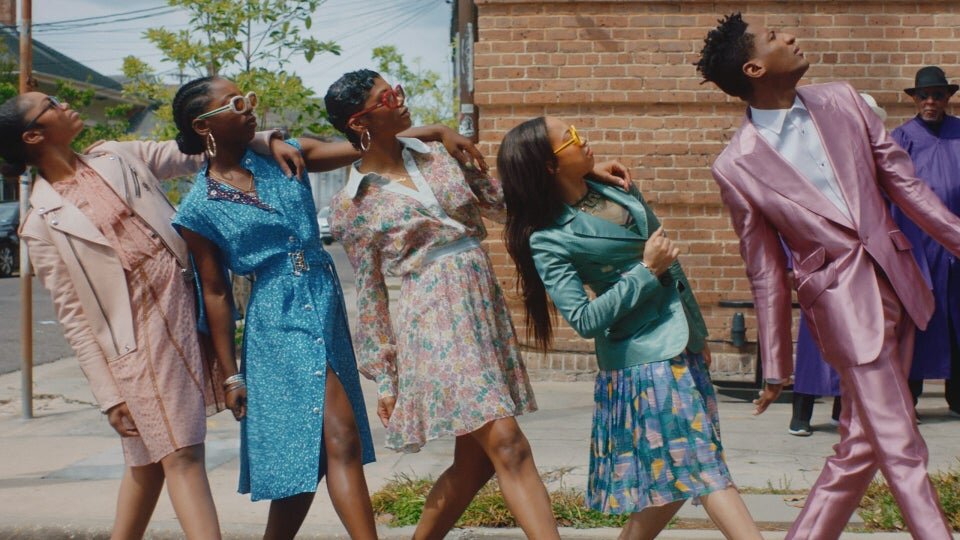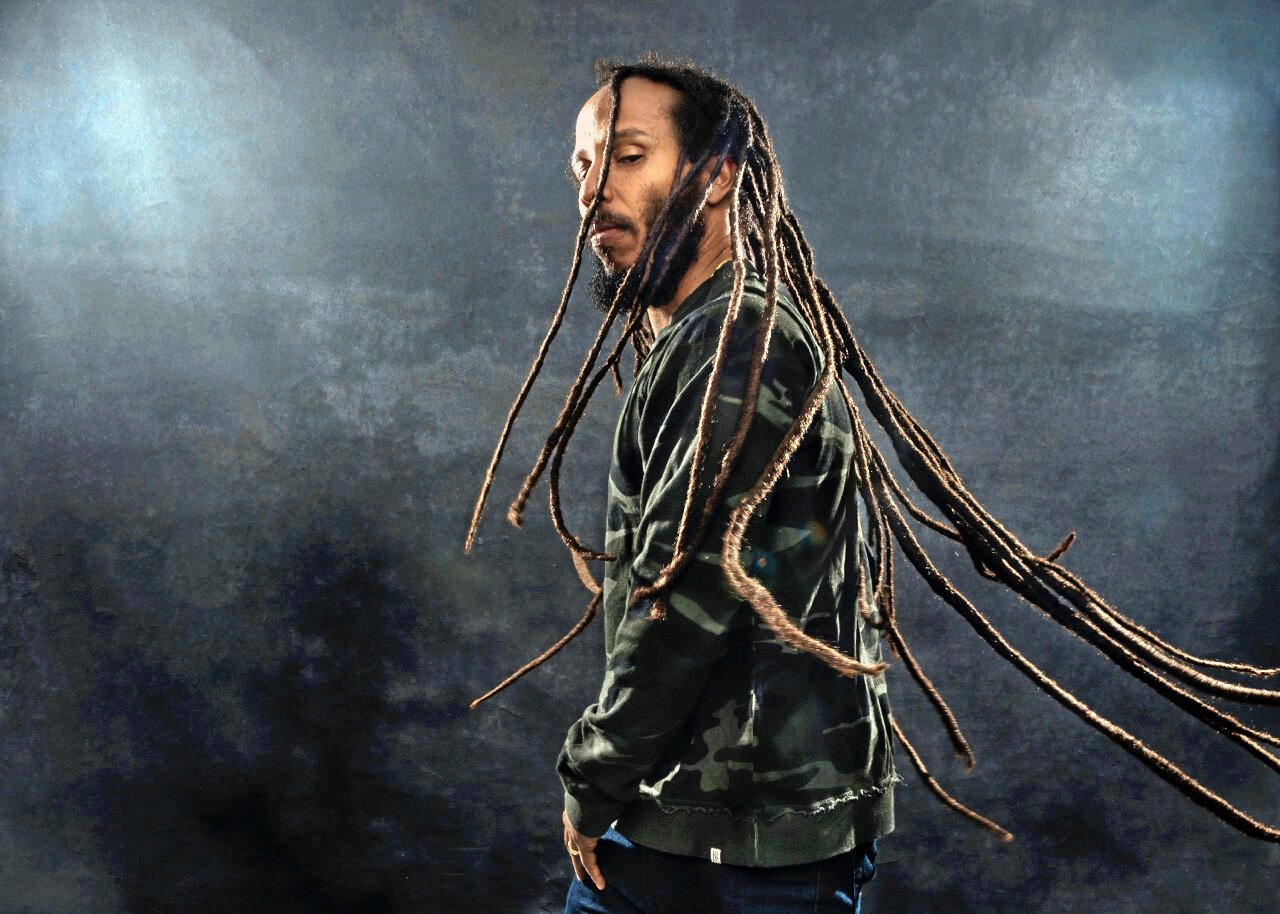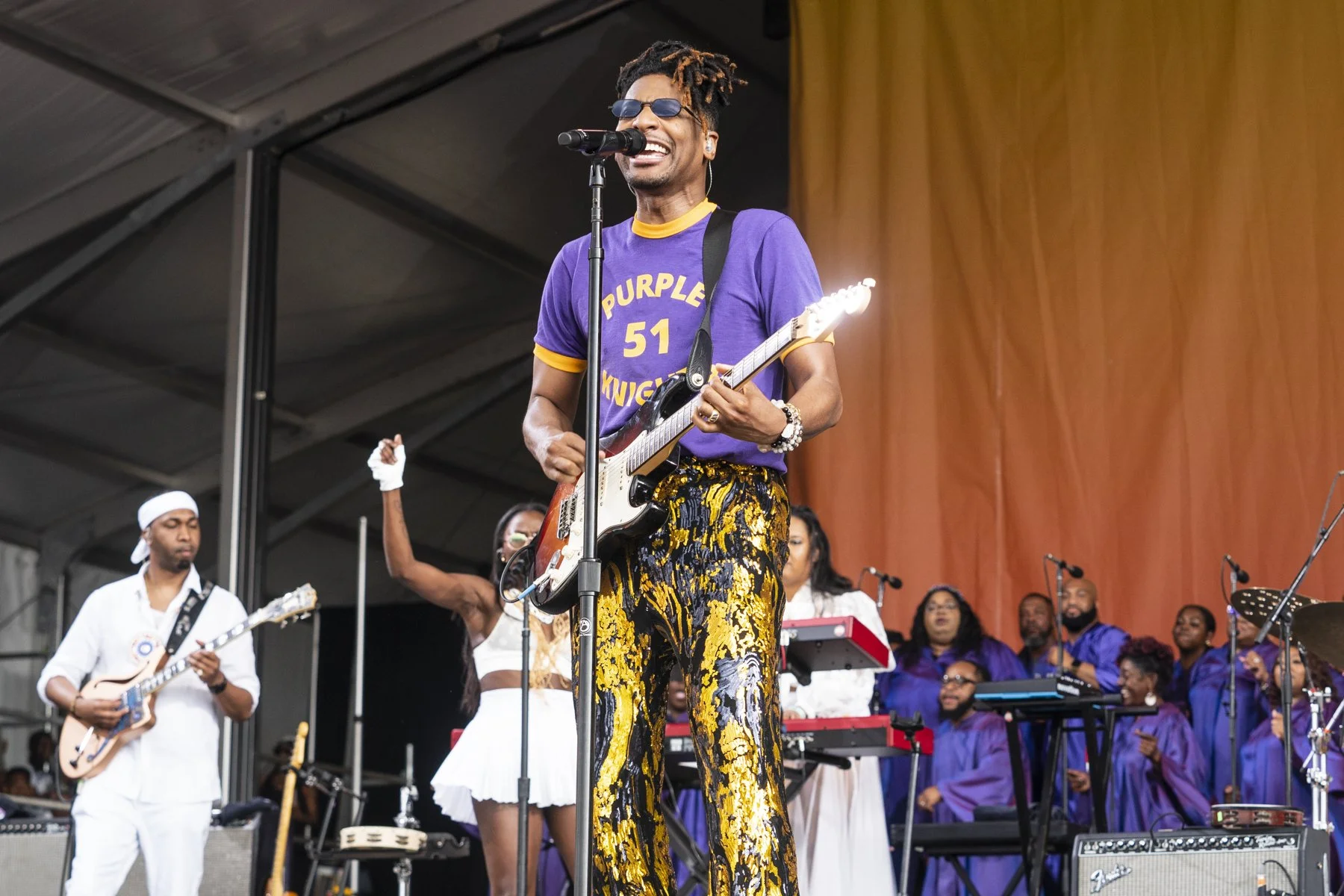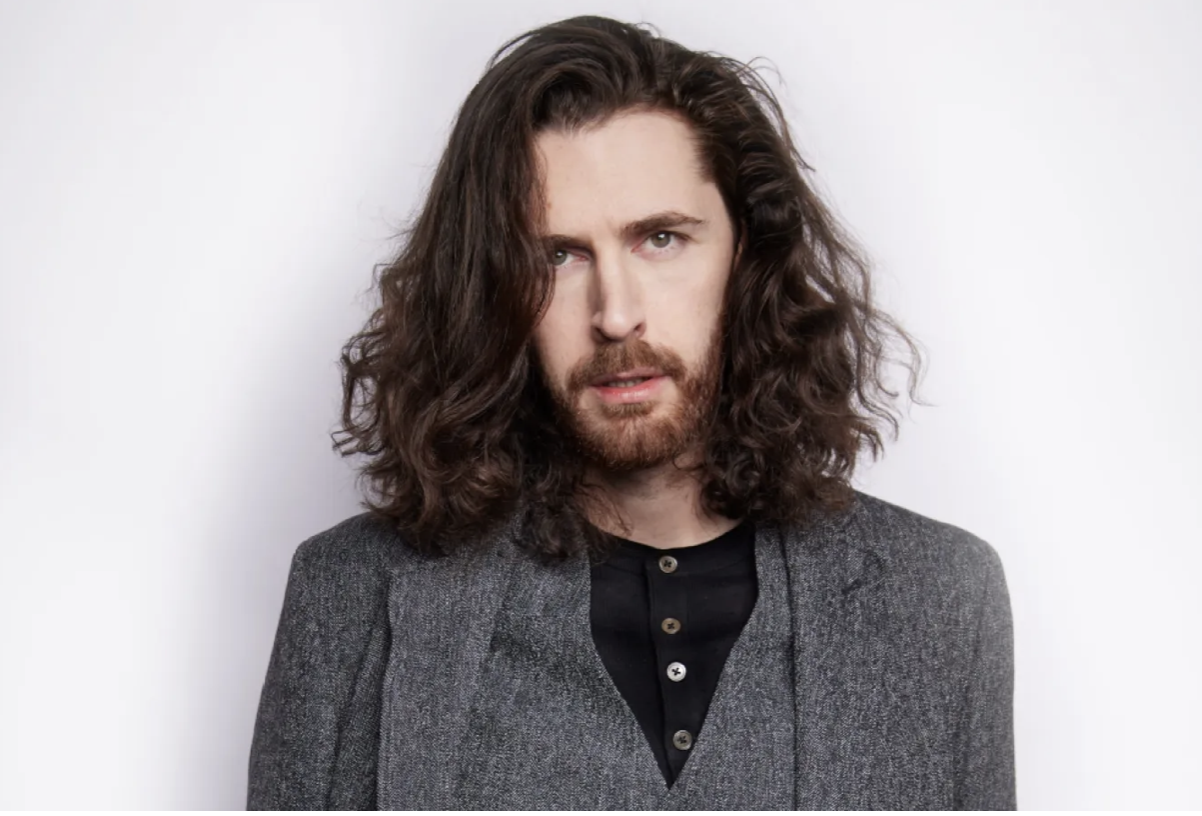Batiste, Tickets, and Going Cashless Part of the Jazz Fest 2023 Story

Jon Batiste at Jazz Fest 2023, by Erika Goldring
Our wrap-up for Jazz Fest 2023 looks at posters, the Cultural Exchange Pavilion, Hurray for the Riff Riff and more.
In most ways, Jazz Fest 2023 was a step up from 2022. The enthusiasm for last year’s Jazz Fest felt like it was aided by the excitement to get back to the Fair Grounds after two COVID years off, and the excitement was disproportionate to the actual lineup.
This year, Lizzo turned out to be a good bet as she drew one of the largest crowds at the Festival Stage, and headliners like her, H.E.R., and Trombone Shorty balanced older headliners including Robert Plant and Alison Krauss, Steve Miller Band, and Dead and Company. For those who spend their festival on the stages between Festival and Shell Gentilly, there were still a number of surprises and acts new to Jazz Fest, which made the festival feel fresher than it has in years.
The clear winner of the weekend was Jon Batiste, who made up for having a scheduling conflict during Jazz Fest in 2022 when he was the subject of the Jazz Fest poster. He played a surprise show at the Maple Leaf, made guest spots with Mumford and Sons and Trombone Shorty, and performed one of the best Jazz Fest sets in a long time. His Friday set echoed Beyoncé’s “Homecoming” set at Coachella, but it had layers that distinguished it. Batiste, for instance, attended St. Aug, so he wasn’t borrowing the iconography and language of a return to high school or college; he was living it, and in a city where your bona fides are determined by where you went to high school, he laid his bare.
Batiste’s macro project has been to explore how he fits into musical communities. Stay Human started as a way to take music to the public in unconventional spaces including the New York City subways. He earned the Colbert gig as a guest who, with his band, led the audience in the theater outside to party in the street. On The Late Show with Stephen Colbert, he shared the stage regularly with musical guests, inviting some including Trombone Shorty to sit in, while backing others. His gig has rarely been to draw the focus solely to him, and on Friday he let the dancers and other singers get as much star time as he got.
He also drew attention the role of Black institutions in the culture of New Orleans and his music, starting with St. Aug and closing with “Freedom,” which makes clear how dotted the line is between Saturday night and Sunday morning in the city’s churches. The ecstatic performances in the gospel tent that cause non-believers to stop and check in during Jazz Fest are the bedrock on which “Freedom” is built, and the show’s frame made explicit how political “Freedom” is. You can’t hear “When I move my body like this / it feels like freedom” at a festival with a Congo Square Stage and not remember that dancing was an act or resistance and an assertion of personhood for Black people in New Orleans from the founding of the city. It’s an inclusive song that also allows anyone to feel connected to their higher self through dancing—and some people near me used a lot of real estate to express that freedom as he played it—but its purpose and power became clearer when played at Jazz Fest.
After Batiste, the story of this year’s Jazz Fest was going cashless. The process of buying food without cash got easier after a disastrous first day, but it was only easy on the first Sunday. The lines were manageable on the second weekend, but after 2 p.m., you had to be prepared to wait longer than you used to for almost anything popular. I have never eaten less at Jazz Fest than I did this year, and the lines for the soft-shell crab po-boy and this year’s new favorite, the lump crabmeat-stuffed beignet, were never short enough to make me stop. If I had not bought a cochon de lait po-boy on the first Sunday, I would have missed that too.
After the first day, I asked what problem going cashless solved. We might have some answers. The festival confirmed that in the past, the sales tax was included in the menu price, whereas this year the sales tax was added on top of the menu price by the software. In all likelihood, vendors working entirely in cash with no hard documentation of sales took some liberties in the reporting of their sales taxes, something the state likely noticed and wanted to see addressed.
One vendor also confirmed that part of their agreement with Jazz Fest is to pay a percentage of their sales to the festival, and that they had been on the honor system until now. Since the digital reader check-out system required the vendor to itemize the sales, a much clearer and more concrete record of sales exists so that the festival can know what it should receive.
One source of slowdown and frustration was the tip screen, which put one more step in the check out process. While some people were glad to have a step built in to make it easier to tip the vendors, many unaccustomed to doing so found it an unnecessary step or felt guilted into tipping. Some people I talked to had worse experiences than that. One realized after the fact that a beer stand had assumed a 20 percent tip on the first day, when the buyer didn’t yet know the system. Another had the seller remind them that the tip button was there, pressuring them to add 15 or 20 percent.
It’s not going away, and as one writer observed in rather generous terms, this is the future of payment at events. It will get faster as the software is improved and we as customers get more accustomed to using it, but the change absolutely affected this year’s Jazz Fest.
“Quarter (Love) Note,” the 2023 Jazz Fest poster by James Michalopoulos
During Jazz Fest, Doug MacCash wrote a piece at Nola.com calling for Art4Now, the company that makes the Jazz Fest posters, to have more women artists and women subjects. I’ll co-sign that idea and anything that produces more interesting Jazz Fest posters. This year’s poster by James Michalopoulos avoided the usual problem of trying to force a clearly identifiable musician’s face into an image by an artist not known for his portraiture chops. The results have often been awkward representations of the subjects and the artists, whose poster work is rarely as fully realized as their own creations.
I’d like to think that this year’s poster is a tacit recognition of the long-standing weakness in their posters as artistic expressions, but my cynical self wonders if it has more to do with no obvious New Orleans subject to spotlight who would also sell posters in the expected number.
My take has long been that Art4Now is in the business of making souvenirs, and that they approach it with the ruthless focus of Bourbon Street T-shirt shops. They likely determined that a poster with a musician’s recognizable face on it sells better than ones that don’t, and it often looks as though the company reads the public’s tastes by making a lap around the fence at Jackson Square. The irony is that a poster for a festival where so much musical creativity and ingenuity is on display represents it in such formulaic ways.
My radical take? Make more posters. More creative posters. How about a black-light poster tied to the appearance by The Dead and Company? A limited edition, retro-looking poster that documented the Festival Stage lineup with Lizzo, Tank and the Bangas, Big Freedia, and Seratones?
A Grateful Dead black light poster from 1976
Here’s another way to think about Jazz Fest tickets: They’re a great deal.
If I want to see Lizzo in Raleigh, NC on Wednesday night, the cheapest seats are $94.50 before Ticketmaster service charges. On Friday in Cleveland, there’s nothing in the upper rack for under $80. Robert Plant and Alison Krauss will play Chattanooga on Saturday, and the cheapest tickets there are $79.50. On Saturday night when Ed Sheeran plays Houston, you can still get tickets for $49 if you want to sit in the third tier for his show at the NRG Stadium. The remaining first tier tickets go for $99 and the general admission on the floor is $125. When the Steve Miller Band plays the Wolf Trap Filene Center in Vienna, Virginia on June 22, it will cost $69 to sit on the lawn at the back of the venue. Any ticket attached to an actual seat costs at least $113, and many cost more than $200. If you’re a fan of any of these artists, a Jazz Fest ticket is equal to or less than the cost of seeing their shows. Everybody else you see at the Fair Grounds is lagniappe.
My suspicion is that there are more people like these at Jazz Fest than the faithful would like to admit. For true believers, Jazz Fest itself is the event, but for many fans of the headliners on the Festival and Shell Gentilly stages, the Jazz Fest date is simply the New Orleans tour stop, and compared to the tickets to their shows elsewhere, Jazz Fest is a sweet deal.
If you’re someone whose festival experience is focused on local acts, do that math. Seeing one of those acts at Tipitina’s will run in the neighborhood of $20. Add a stop at the Maple Leaf and it will be another $15 to $20 depending on whether you buy your tickets in advance or at the door. It’s a Sunday and you want to see The Hot 8 at The Howlin’ Wolf? Another $20 in advance or $25 at the door. Dr. Michael White at Snug Harbor next Thursday? $30. Trumpet Mafia at Chickie Wah Wah on May 25? Another $25. If you’re physically able to see the acts you want to see on one night, it costs as much as a Jazz Fest ticket.
Mia Huber covered the second Saturday for My Spilt Milk this year, and in addition to her reviews of The Dead and Company and H.E.R., she had these notes:
- Hurray For the Riff Raff had more of a folk-rock set up this year at Jazz Fest, with an organic and stripped down sound in comparison to years past. Hurray had the slot before The Lumineers on the Gentilly Stage, and among the fans of the latter was a small crowd of Millennials that was absolutely insufferable. There was lots of talking, a few hecklers, and a person in a hat that said “Ya Boix” in the La Croix logo who everyone collectively prayed would leave.
Despite the noise, the show was great. Segarra played “Let Her in the Sky,” a song recorded for Life on Earth released on the Deluxe Edition. It showed strong Americana roots as she sang, “You don’t have to die / If you don’t wanna die” in a raspy, Dylan-esque tone. They gave a speech about bodily autonomy before going into “The Body Electric,” a song about gender-based violence that was even more chilling underneath the endless gray sky. “This is a song that I hope one day will be irrelevant,” Segarra told the crowd before going into the pulsating strumming pattern. Through the noise and the rain, they stood strong.
- Some of the coolest moments at Jazz Fest happen in the Cultural Exchange Pavilion. This year, it spotlighted Puerto Rican artists, vendors, and performers as a part of the fest. Emplegoste is a fast paced Afro-Latinx band from Puerto Rico that featured bongos backed by a full drum kit, synthesizers, brass instruments, and call-and-response vocals. The Jazz Fest dads took a step back, so the tent was filled with people actually dancing.
The most exciting part of the show came from a member of the band who didn’t play any of the instruments, but served as a sort of hype man. He was around 60 years old and busting it down, doing fake strip teases and jumping into the audience to get people to move to the beat.
Mia’s reports clarified a thought for me. Some of my best times in Jazz Fest in the last few years have been in the Cultural Exchange Tent, in part because some of the most contemporary and provocative booking at the festival falls in its purview. This year I loved sets by Las Cafeteras, Mdou Moctar, La Tribu de Abrante, and Pirulo y la Tribu, in part because of the musicians themselves, but the intimacy and the unity of the space helps immensely. Nobody’s there holding a spot for the next set, and the party gladiators who want to see The Lumineers don’t care about bomba or salsa, and they sure as hell don’t dance. Las Cafeteras and Pirulo got the crowd trying to shake their hips from side to side, something that many in the audience don’t do easily. And for people can, it’s a chance for them to actually dance with other people rather than amiably bob along to the beat of a show on one of the bigger stages.
I’m usually pleasantly surprised by how congenial Jazz Fest audiences are, but there’s a lot to be said for a space that’s just for the hardcore. Lagniappe Stage has a similar vibe as a space that is always a deliberate choice. Nobody hears music there and is distractedly sucked in. It’s a destination, so the crowd is usually very supportive.
Creator of My Spilt Milk and its spin-off Christmas music website and podcast, TwelveSongsOfChristmas.com.








